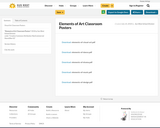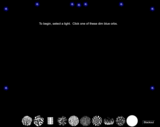
Visual Art Classroom Posters
- Subject:
- Arts Education
- Material Type:
- Primary Source
- Date Added:
- 07/23/2018

Visual Art Classroom Posters

This week, we're headed back to England to learn about Sentimental Comedies. They weren't that funny, but they were definitely sentimental. The people of England were shaking off the Restoration hangover, and bawdy plays no longer had a place. In fact, there wasn't a place for much of any drama, as only two theaters were licensed to present plays. Rules and regulations everywhere, y'all.

The Renaissance came to England late, thanks to a Hundred Years War that ran long and lasted 116 years, and then a civil war to decide who would be the royal family. BUT after all that, with the Tudors (relatively) securely installed on the throne, there was a flowering of humanism, science, and culture. Theater was a big part of it. Today, we're talking about the London theater scene and the playwrights that set the stage...ahem...for the main man of English Theater, William Shakespeare.

This week on Crash Course Theater, Shakespeare is dead. Long live Shakespeare. Well, long live English theater, anyway. Actually, it's about to get banned. Anyway, we're discussing where English theater went post-1616. We'll talk about Ben Jonson, revenge tragedies, and court masques.

Join us here, in the darkness. Our theater journey takes us into the heart of expressionism today, as playwrights in the late 19th and early 20th centuries explored the limits of human beings' tolerance for a mechanized, industrial world. Spoiler alert: those playwrights didn't think humans fared very well in the industrialized world. They EXPRESSED that concern about modernity through some pretty dark plays, with pretty dark sets, and pretty dark content.

The 1930s in the United States were pretty bad for employment in all industries, and the theater was no exception. As part of Roosevelt's New Deal, the Works Progress Administration created a division called the Federal Theatre Project. The agency created theater companies across the country to put actors and crew back to work in the theater industry. The shows were free, and thanks to forward thinking administrators, a lot of them were pretty interesting. You'll also learn about the Group Theatre today. They're the super-influential troupe, with the totally lame name.

It's time to go Back...to the Future. By which I mean, we're going back into the past to talk about Futurism. Which seems like it would be cool, but it was started by this terrible guy Martinetti, who also wrote the Italian Fascist manifesto. He was just the worst, but, at least he was the worst in a way that makes a pretty compelling video.
We'll also check in with the Russian theater, and learn about generally nicer Futurist Vsevolod Meyerhold, who also was vey influential in constructivism. So get ready to fire up the meaning machine and learn!

Not long after drama reappeared in the unlikely home of European churches, the church decided again it didn't like theater. And so, the budding dramatic scene was kicked out into the harsh elements of the outdoors. So, they started having plays outdoors. Today we'll learn about mystery plays, cycle plays, pageant wagons, and how medieval European theater moved from being a religious phenomenon to a secular one.

Arts Education Planning Supports- Year Plan, Co-constructing criteria, drama organzier

Get ready for hilarity, because this week, we're diving head first into Greek Comedy. Actually, though, maybe don't get TOO ready for hilarity. Taste in humor has changed a little over the last couple of thousand years. You already know about Greek Tragedies, with their hamartia and catharsis and whatnot. Today we're going to look at how Greek comedy evolved out of those tragedies, first as Satyr plays, and later as full-blown comedies. So come along. There are a few laughs involved, I promise.

In the 1920s, there was a blossoming of all kinds of art made by African Americans in the New York neighborhood Harlem. Let's call it a renaissance. While all the arts were having a great run, some extremely interesting things were happening in the theater. Writers like Langston Hughes and Zora Neale Hurston were writing plays, and black theater companies were drawing larger audiences than ever before.

Let the power of imagination and inference serve as a ńtime machineî to bring Benjamin Franklin into the classroom! History and science come to life in a dialogue with Franklin the inventor, developed through lesson activities that incorporate research, imagination, writing, visual arts, and drama.

Prepare to be horrified, and to look into the face of inhumanity with the Grand Guignol. Mike Rugnetta teaches you about one of theater history's most horrible chapters. The Grand Guignol was a French theater based in Paris from the late 19th century until 1962. The troupe, led by writers like Andre de Lorde and Alfred Binet put on dark, violent, bloody shows that were a precursor of the horror media that we love to consume today. You'll learn about stage effects, makeup, and maybe even why humans like to stare into the darkness and terrify themselves.

This comprehensive site from North East School Division provides resources for:
*Elementary Students - Arts, Social Studies, ELA, Health, Science
*High School Students - Arts, Social Studies, Math, Health, Science, French, ELA, Drama, PAA, Psychology
*Multi-Age
*Adults & Teachers
*Legends

We're headed back to Japan, this time in the Edo period to follow up on Noh theater, which had gone out of style last time we checked in. Now, under the Shoguns, there's couple of really interesting types of drama on the scene. Kabuki is a sort of successor to Noh, with wilder stories and more action. And Bunraku is straight up high intensity puppet theater. Mike tells you all about how the Samurais got themselves into trouble watching bawdy theater shows in Edo.

This week on Crash Course Theater, Mike is taking you to Japan to have a look at Noh theater. Noh, and its counterpart Kyogen are some of the most revered theater forms in Japan, and are still performed today. Today you'll learn how Noh grew out of traditional Shinto dances, what a Noh theater looks like, and how audiences managed to sit through 8 hour performance in the days before memory foam theater seats. (hint: it was the Kyogen)

The Folger Shakespeare Library provides the full searchable text of "Henry V" to read online or download as a PDF. All of the lines are numbered sequentially to make it easier and more convenient to find any line.

In the early 20th century United States, big melodramatic productions were on Broadway, and everywhere across the country. Which inevitably led to an Avant-Garde backlash. An interesting part of the backlash was Little Theater, a movement that embraced smaller, more emotional, and less profitable forms of drama. One of Little Theater's most notable practitioners, Eugene O'Neill changed the theatrical landscape with groundbreaking plays like The Iceman Cometh and Long Day's Journey into Night.

LIVE (Live Interactive Video Education) Arts Education is a dynamic distance education arts program for students in Grades 1 to 9. The program supports the Saskatchewan Arts Education curriculum and is delivered via the Saskatchewan Ministry of Education LIVE Network (CommunityNet).
Teachers sign up for grade specific programs then professional Artists connect simultaneously with teachers and students in multiple schools across the province of Saskatchewan for a LIVE experience with Arts Education.
Information about the grade level, arts strand, guest artist, date and time and program guides are listed on this website.
This program started out in 2005 as an Artist in the School distance education pilot program hosted by Regina Catholic Schools. Initially the broadcast programming was delivered by Mixed Media Artist in Residence Heather Cline from a special distance education broadcast classroom at St. Peter School in Regina. The program has continued to expand and evolve responding to the needs of Saskatchewan Teachers and the new Saskatchewan Arts Curriculum.
Last year the LIVE Arts program, in partnership with several Saskatchewan School Divisions, broadcast 36 programs featuring Professional Artists in the areas of Visual Arts, Drama, Music and Dance. Each program featured a Guest Artist working with a classroom teacher and their students. Teachers and students participating via distance technology followed along with the help of a guide that outlined the broadcast portion of the program and provided teachers with a follow-up hands-on activity.

An online simulation to see how GOBO's are used in theater and stage design.